The depth of the sewer - the main aspects of this issue
When carrying out design and installation works on the device of sewer systems it is necessary to be guided by a number of norms. Moreover, if the slope angle, the diameter of pipes and other factors have constant values, then the depth of the sewage system according to SNiP may differ significantly depending on the climatic zone in which the work is carried out. In this article we will look at this issue in more detail and highlight the most important aspects.
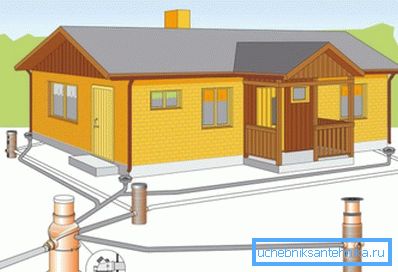
Nuances that must be considered when determining the depth of the strip
All information relating to the issue under consideration is set out in SNiP 2.01.01-82. The following important factors can be distinguished from this regulatory act:
| Climate belt | This indicator is largely fundamental, so all design work begins with it, below is a diagram that determines the depth of sewage pipes laid down by SNiP. You need to find your location, and find out the desired depth value. |
| Plot relief | If the platform on which communications will be laid is absolutely flat, then this factor can be ignored, but if the plane is uneven, then, accordingly, the depth of the pipeline also changes. |
| Load on structures | Again, if there is no transport on the site, then you should not worry about the loads, but if the system is laid under the passage, road or platform, along which transport sometimes goes, then increased deformation effects should be taken into account, since they can cause damage to pipes |
| Materials used | If iron casting or thick-walled asbestos pipes are used, then you should not worry about the load, but if you decide to use plastic, the price of which is much lower, then you need to pay special attention, because, despite durability, such elements are much easier to damage. |
| Design features | For example, the depth of laying sewer pipes in a private house is significantly different from industrial construction due to a number of features that we consider below |
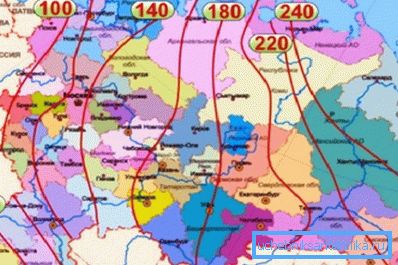
Order of work
Consider the sequence in which all activities are carried out, and how to organize the workflow in order to minimize the likelihood of errors and miscalculations (see also the article The Deviation of a Sewage Pipe is an important indicator for effective work).
Freezing depth
This indicator can be found either in the directory “Construction climatology” or in local metrological agencies. It should be noted that the indicator can vary significantly depending on the type of soil, as can be seen by reading the table.
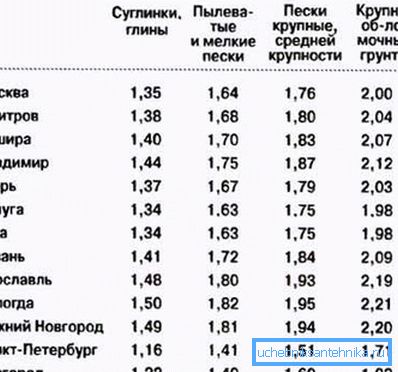
This type of communication has some features that you need to know when calculating the depth:
- Due to the fact that pipes with constantly high temperatures run through the pipes, their depth differs from ordinary communications and standard plumbing systems. This is a very important factor directly influencing the laboriousness of the work and the time it takes to complete it.
- The index of the depth of the strip depends on the diameter of the elements used. If this indicator is less than 50 centimeters, then 0.3 meters can be subtracted from the value of the depth of frost penetration, or more than 50 centimeters, then 0.5 meters. That is, with an indicator of 1.5 meters of communication, a diameter of 110 mm can be laid on a recess of 1.2 meters.
Tip! If it is impossible or very difficult to put communications at the right depth, then you can use a special insulation for pipes, which will prevent freezing and will significantly simplify work. In some situations, this is the only appropriate solution.
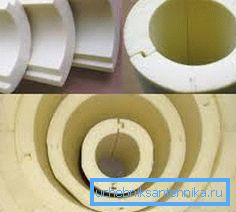
Terrain features
If the site has differences in height, it is important to follow a few important rules:
- The simplest option for calculating the depth is to determine the lowest section, and it is impossible to make calculations from this point, since the drops are undesirable, you cannot dig a stepped trench in any case, because the slope must be uniform along the entire length of the line.
Note! An excessively large, as well as too small, bias adversely affects the operation of the system and leads to an accelerated formation of plaque on the inner walls of pipes, which significantly increases the risk of blockages.
- With the complexity of the work due to the large drop in height or other factors, it is possible to warm the part of the system that will be closer to the surface than it should be, and to lay the remaining sections without using insulating elements.
- It is very important to ensure high-quality fixation of each element so that after falling asleep the pipes do not bend, since in such cases there is a high probability of leakage.

The scheme of laying depth is very important during the preparatory stage - the sewage system in a private house is not complicated, so it is not difficult to create a project, and the factors described above will serve as a kind of instruction.
Features of the work
If you have decided on how deep to bury the sewer pipe, you can get to work:
- The trench is dug 15-20 cm deeper than required. This is necessary in order to make a sand-gravel pillow, which must be carefully tamped.
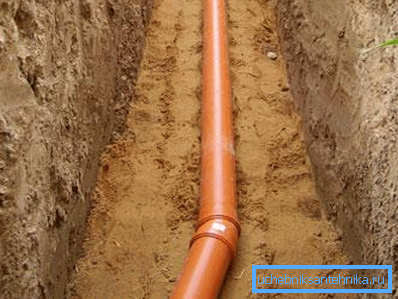
- Next is the process of laying, it should start from the foundation of the house. It is important that the depth of laying of the sewer pipe also provided for the required slope, for pipes with a diameter of 100 to 200 mm, this indicator is 2 cm per meter, that is, the height difference by 10 meters should be 20 cm.
- To ensure the lowest pressure on the pipes, narrow trenches should be dug; it is also possible to install wooden struts over the pipe every meter to reduce pressure.
- To ensure maximum tightness of the joints can be further strengthened by applying a silicone sealant, after curing, it will create an insuperable barrier for moisture.
- After assembly, the system must be checked for leaks, the easiest option is to fill it with water.
- The last stage - falling asleep communications ground.
The depth of the rain sewer can be less, since in winter the pipes are empty and the frost is not terrible. But it is important that the system does not accumulate water during precipitation.
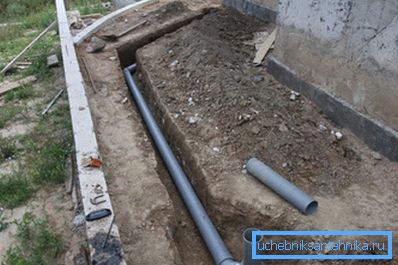
Conclusion
As you can see, the depth of the sewage system is very important, otherwise the frost can simply stop the system (see also the article Septic tanks for sewage is a key element of the autonomous sewage system).
The video in this article will tell some important nuances regarding the topic discussed in the article.